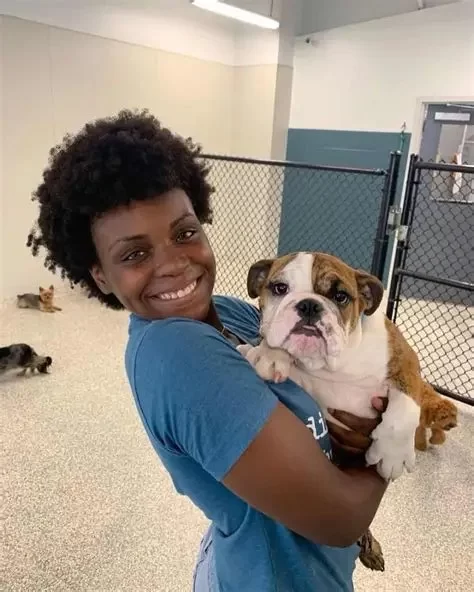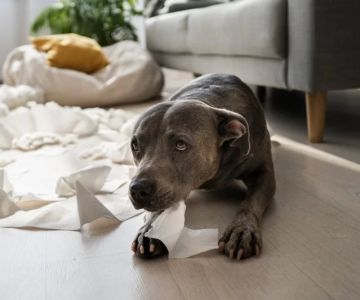1. Understanding Separation Anxiety in Rescue Pets
Rescue pets, particularly dogs and cats, may face a variety of challenges when adjusting to their new homes. One of the most common struggles is separation anxiety, a condition that can manifest in destructive behaviors and distress when left alone. Separation anxiety occurs when a pet becomes overly attached to their owner and struggles with being separated, even for short periods. It’s especially common in rescue pets, who may have experienced trauma, neglect, or abandonment before being adopted.
Recognizing and addressing separation anxiety in rescue pets is crucial for their well-being and your relationship with them. In this article, we’ll explore how to identify the signs of separation anxiety, provide strategies for managing it, and share stories from real pet owners who’ve worked through this challenging issue with their furry friends.
2. Symptoms of Separation Anxiety in Rescue Pets
Understanding the signs of separation anxiety is the first step in managing the condition. Each pet is unique, but there are several common behaviors that can indicate your rescue pet is struggling with anxiety when left alone. Look out for these key symptoms:
2.1 Excessive Barking or Meowing
One of the most common signs of separation anxiety in rescue pets is excessive barking or meowing when left alone. This vocalization can be constant, especially during the initial stages of your absence. While some barking is normal, it becomes concerning when it persists for long periods or happens every time you leave.
2.2 Destructive Behavior
Destructive behaviors are another red flag. Pets with separation anxiety often chew furniture, scratch doors, or tear up household items like shoes or pillows. This behavior stems from the pet's stress and frustration at being left alone, often leading to physical destruction of their environment.
2.3 Urination and Defecation Inside the House
Pets who are house-trained may start urinating or defecating inside when experiencing separation anxiety. This isn’t a sign of poor behavior, but rather a reaction to the stress of being left alone. It’s important to understand that these accidents are a sign of distress, not defiance.
2.4 Pacing and Restlessness
When a pet with separation anxiety is left alone, they may exhibit pacing or restlessness, moving around the house in circles or back and forth. This anxiety-driven behavior is a physical manifestation of their discomfort when separated from their owners.
3. Why Rescue Pets Are More Prone to Separation Anxiety
Rescue pets are particularly vulnerable to developing separation anxiety due to their past experiences. Many of these animals have faced neglect, abandonment, or abuse, which can leave deep emotional scars. When they are finally placed in a loving home, they may feel insecure or fearful of losing their new family, leading to anxiety when separated.
3.1 Traumatic Past Experiences
A significant number of rescue pets have lived in stressful environments before being adopted. Some may have been abandoned or mistreated by previous owners, which can lead to a heightened sense of attachment to their new caregivers. This deep attachment, while a sign of love, can also trigger anxiety when left alone.
3.2 Lack of Socialization
Some rescue pets, especially those rescued at a young age, may have missed critical socialization experiences. This can cause them to feel insecure or fearful, especially when separated from their owners. Socializing these pets with other animals and people can help, but it takes time and patience to build their confidence.
4. Effective Strategies for Managing Separation Anxiety in Rescue Pets
Addressing separation anxiety in rescue pets requires a combination of patience, training, and positive reinforcement. Here are several strategies that can help your pet cope with separation anxiety and feel more secure when you’re not around:
4.1 Gradual Departures and Arrivals
One effective method for easing separation anxiety is to gradually desensitize your pet to your departures and arrivals. Start by leaving the house for short periods of time, and gradually increase the duration as your pet becomes more comfortable with the idea of being alone. Avoid making a big fuss when leaving or returning home, as this can reinforce your pet's anxiety.
4.2 Create a Safe Space
Establishing a safe, quiet space where your pet feels comfortable can make a big difference. Consider using a crate or a designated area with their bed, toys, and familiar scents. This safe space can help them feel more secure when left alone and reduce feelings of fear or distress.
4.3 Provide Mental and Physical Stimulation
A tired pet is often a happy pet. Before leaving, provide your rescue pet with plenty of mental and physical stimulation. This can include a long walk, playtime, or interactive toys that engage their mind. The goal is to wear them out so they are less likely to experience anxiety and more likely to rest while you’re gone.
4.4 Use Positive Reinforcement
Positive reinforcement is crucial for modifying behavior. Reward your pet with treats, praise, or affection when they remain calm during your departures and returns. This helps them associate your absences with positive experiences rather than anxiety. Avoid punishing your pet for anxious behaviors, as this can increase their stress levels.
5. Real Stories: How Pet Owners Have Successfully Addressed Separation Anxiety
Many pet owners have successfully helped their rescue pets overcome separation anxiety. Here are a few real stories that highlight the power of patience, training, and understanding:
5.1 Daisy the Dog
Daisy, a rescue dog from a local shelter, struggled with severe separation anxiety when her new owners adopted her. She would bark incessantly, destroy furniture, and refuse to eat when left alone. Her new family worked with a professional trainer who used gradual departures and crate training to help Daisy feel safe. Over time, Daisy learned that her owners would always come back, and her anxiety significantly decreased. Now, Daisy enjoys her alone time, often napping in her cozy bed without anxiety.
5.2 Max the Cat
Max, a rescue cat, was extremely shy and would hide when his owners were preparing to leave the house. His family used a combination of safe space training and positive reinforcement. They created a quiet space for Max with his favorite toys and treats, and over time, he grew more confident being alone. Today, Max is much more relaxed and even waits by the door for his family to return, knowing he’s safe.
6. Additional Help: When to Seek Professional Support
While many pets can improve with gradual training and care, some may require professional help to fully overcome separation anxiety. If your pet’s anxiety persists or worsens, it may be time to consult with a veterinarian or a certified animal behaviorist. They can assess your pet’s situation and provide tailored solutions, such as medication or more advanced training techniques, to help alleviate their anxiety.
If you're looking for expert advice on addressing separation anxiety in your rescue pet, visit Hidden Brook Veterinary, where our team can guide you through the process and offer recommendations tailored to your pet's specific needs.












